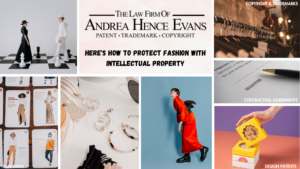Protecting fashion designs involves a combination of intellectual property (IP) laws, including copyright, trademark, and design patents. Here’s a breakdown of each:
-
1. Copyright: Copyright protects original works of authorship fixed in any tangible medium of expression. In fashion, this can include original fabric prints, artwork, sketches, and patterns. However, it does not protect functional aspects of clothing, such as the cut or style. Copyright protection is automatic upon creation and lasts for the lifetime of the creator plus 70 years. Registering copyrights with the relevant authorities can provide additional legal benefits in case of infringement.
2. Trademark: Trademarks protect brand names, logos, symbols, and slogans that distinguish goods or services from others in the market. In fashion, trademarks are essential for protecting brand identity, such as logos on clothing, hang tags, and labels. Registering trademarks with the appropriate government agency (e.g., USPTO in the United States) provides legal protection and exclusive rights to use the mark in commerce.
3. Design Patents: Design patents protect the ornamental design or appearance of functional items. In fashion, design patents can be obtained for unique and non-functional design elements of clothing or accessories, such as jewelry or handbag designs. Unlike utility patents, design patents focus solely on appearance rather than functionality. Design patents typically have a shorter term of protection compared to utility patents, usually around 15 years.
4. Trade Dress: Trade dress protects the overall appearance or “look and feel” of a product, including its packaging, design, color schemes, and other elements that make it distinctive. In fashion, trade dress protection can extend to unique store layouts, product packaging, and even distinctive uniform designs.
5. Contractual Agreements: Fashion designers can also protect their creations through contractual agreements, such as non-disclosure agreements (NDAs), non-compete clauses, and licensing agreements. These contracts help safeguard proprietary information and prevent others from copying or reproducing designs without permission.
It’s important for fashion designers and brands to carefully consider which forms of IP protection are most suitable for their designs and business objectives. Consulting with IP attorneys who specialize in fashion law can provide valuable guidance on navigating the complexities of IP protection in the fashion industry. Let us know how The Law Firm of Andrea Hence Evans, LLC can help you.

